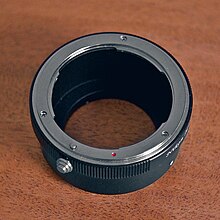Lens adapter
Lens adapter (English lens adapter ) are components with which camera lenses of camera housings can be fixed, even though the lens and the housing do not have an identical lens mount or lens thread feature.
description
Lens adapters make it easier to switch to a different camera system , and used and older lenses can continue to be used in this way.
Passive adapters are only used to attach the lens. They do not transmit electrical signals. Any autofocus , image stabilization and / or spring shutter functions in the lens are consequently not available. The distance setting and the setting of the aperture diaphragm must be carried out manually. Furthermore, no metadata is transferred to the camera housing, such as data in the standardized Exif format, so that these cannot be called up in the image files. Automatic compensation of imaging errors is therefore not possible; these may have to be corrected manually in the course of subsequent image processing .
Active adapters establish electrical connections between the camera housing and lens. These can be used to supply power to the lens and as an analog or digital interface , which can be used, for example, for automatic distance adjustment or for controlling the aperture diaphragm.
While theoretically any lens can be mounted on any housing, in practice there are limits, for example because an adapter is not even available. Be further has the adapter so constructed that the flange (English flange focal distance ), namely the distance between the original lens mount and the film or the image sensor , is maintained. Otherwise the lens cannot be focused on a wide or infinite object distance. For this reason, it is relatively easy to mount the lenses of single- lens reflex cameras on mirrorless system cameras , since the latter usually have a significantly smaller flange focal length.
In the case of digital camera housings, the image circle of the lens used must completely cover the area of the image sensor so that there is no excessive shadowing in the corners of the image (see also edge light drop ). If the image circle of the lens is only partially used, the result is a smaller angle of view , which leads to an apparent change in the focal length . This fact is described by the term format factor .
Special designs
Some adapters also have optical elements, such as telecompressors (English: focal reducer ), which reduce the focal length of the system and enlarge the effective aperture .
Conversely, with teleconverters (English: teleconverter ) the focal length of the system are increased, the effective aperture becomes smaller.
Another special design are electronically controlled adapters which enable focus bracketing ("auto bracketing") on some cameras that do not have this function provided by the manufacturer (e.g. Canon EF lenses on Micro Four Thirds cameras or as an intermediate ring for Canon EF or Nikon F bayonet), for example to simplify the creation of image series for focus stacking .
Web links
- Old lenses on digital system cameras , compatibility table


